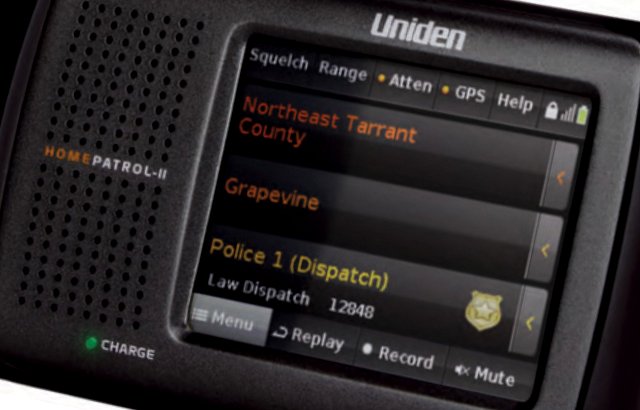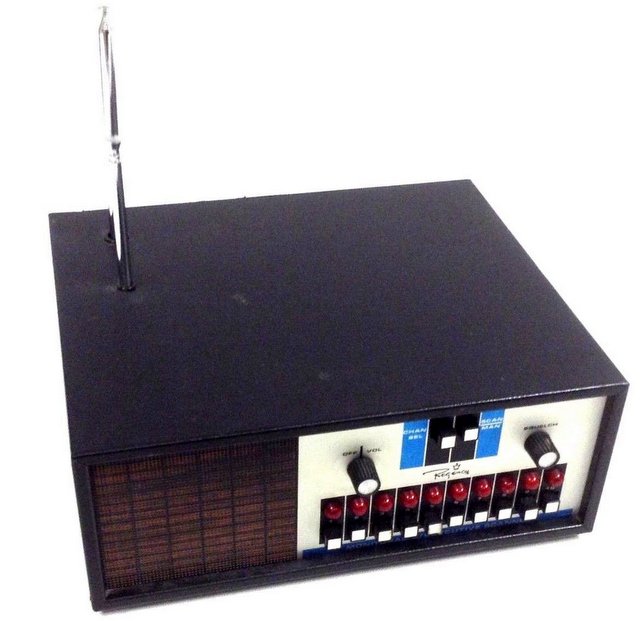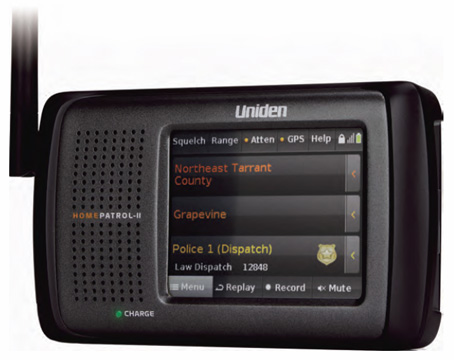 Since I was a kid, I’ve always enjoyed listening to police, fire, public services/utilities, and aviation communications on scanners. Growing up, my father had a Regency Executive scanner in our living room, and he used it to listen to all of the local action before it was published in the newspaper the following morning. All so fascinating to a kid like me, listening in. Ah, those were the days…!
Since I was a kid, I’ve always enjoyed listening to police, fire, public services/utilities, and aviation communications on scanners. Growing up, my father had a Regency Executive scanner in our living room, and he used it to listen to all of the local action before it was published in the newspaper the following morning. All so fascinating to a kid like me, listening in. Ah, those were the days…!
The Regency scanner was populated with crystals, and I fondly remember accompanying my father to our local radio shop to purchase new crystals for various frequencies. My father still has and uses this scanner today––evidently, a few of our hometown services still use the same frequencies they used back in the 1970s.
But oh, how times have changed
As the years have passed, public services moved to more complex communications systems including trunking, and now a host of digital modes have come to the fore, some even encrypted.
My interest in scanner technology frankly waned during the 1990s. I suppose this had to do with the amount of travel and moving I was doing at the time. In the 1990s, for example, I lived in at least seven different communities in two countries. Between 2000-2010, I lived in five different communities in three different countries. I always remained dedicated to shortwave radio, of course, because while frequencies changed, I could receive many stations in Europe that I could also receive in North America. I knew that scanner frequencies, by their very nature, vary community-to-community, so I didn’t bother.
Truth is, I simply lacked the patience to program (relatively complicated) scanners. Not to mention, I was really put off by the idea of traveling with a scanner, thus requiring a thick frequency guide just to hear local services.
Welcome to 2017
I n the past few years, technology has made a big leap forward in the scanner world. With robust on-board memory, GPS capabilities, and dynamic frequency databases searchable by postal code and/or GPS coordinates, keeping an up-to-date scanner is now a great deal easier––brilliant developments for a scanner newbie like me!
n the past few years, technology has made a big leap forward in the scanner world. With robust on-board memory, GPS capabilities, and dynamic frequency databases searchable by postal code and/or GPS coordinates, keeping an up-to-date scanner is now a great deal easier––brilliant developments for a scanner newbie like me!
So, exactly why do I want a scanner all of a sudden? I mainly want one to keep in the messenger bag I carry with me everywhere. I’d like something to take on travels, perhaps help me listen in on traffic problems or simply eavesdrop on the local public service scene to understand what’s happening around me. Moreover, I find I love listening to aviation frequencies! And though I travel with other radios, the ability to tune NOAA frequencies would be super, too.
I started thinking about scanners last year when we experienced a forest fire in our community. We discovered the fire as we traveled home that day, and found our local road blocked to traffic for about an hour as emergency vehicles moved in. Fortunately, I carry a Yaesu VX-3R in my messenger pack and was able to find the frequencies the fire department was using to communicate with the fire-spotting plane circling overhead. It gave me some measure of comfort to hear that things were almost contained at under twenty acres. In truth, many of us were thinking through a possible evacuation scenario since, at the time, massive forest fires were flaring in various parts of the state.
So, here’s my question to readers in-the-know regarding scanners: can you help me find the perfect scanner for the following requirements…?
- Handheld (not mobile/base)
- Easy to program
- GPS capability
- Updated frequency databases that can be stored internally
- Able to receive as many analog and digital modes as possible
- Relatively durable and compact
- Long runtime on batteries
A friend recommended the Bearcat/Uniden BCD436HP, a scanner that seems to have a lot of the functionality I seek.
I know that Uniden Homepatrol II is also recommended by many.
Also, the Whistler company has a number of scanners and a large following, as well.
Hmm…So many choices!
Post readers, can you help me out? What sort of scanner do you recommend, and why?



Hello Avo, Steve and others. I have my own conundrum. (I wish to point out that my next scanner will be my first) My wife and I have a Caravan Park cabin down by a coastal town in South Eastern Victoria, Australia. I have set up a 2 metre radio at the cabin and that works fine back into Melbourne via a four element, 146 MHz yagi.
My issues is that I still require my HF SWL fix plus knowing what is going with local emergency services in the area. The Country Fire Authority in Victoria is one of those services I would like to listen into at both home in our Bush-fire block and down by the sea.
I am considering a number of portable SW Radios like the Sangean 909x, Commradio CR1-a, Commradio CTX-10, IC-R30, Uniden UBCD-436PT, UBCD 325PT. I appreciate that the IC-R30 and Commradio CTX-10 are yet to be made available and I suppose I will have to be more patient until their eventual release.
The IC-R30 would appear to answer all my requirements in one radio. Though it looks like it will not do trunking. Is Trunking a feature that I should look for in a radio? Maybe Avo or others could answer this please? My funds are limited, though I do like purchasing quality items. Also on a last note all our computers are Macs of one form or another. I can see the eventual requirement for a PC laptop. I have been told to go with a system that uses Windows 8.1.
Thank you for your time and help.
Warm regards,
Mitch.
Thomas: Did you purchase one? If so, which one? And how do you like it?
Struggling with the same dilemma. Haven’t bought a scanner since the Bearcat 780XLT was the hot box. My unlocked RS / GRE Pro 2004 still works, even the electroluminescent display, as does my Bearcat 895XLT. They all still work and they have all been basically rendered useless in my area and rebanding. The events of the past summer have gotten me interested in scanning again just to stay abreast of my local area.
Pretty much seems like the choice is between the Bearcat BC536HP and the Whistler TRX-2 for base units. ProVoice and GPS places the ball squarely in the Bearcat’s court but the TRX-2 offers NXDN, released the free upgrade over Christmas, and zip code programming. I do like the Bearcats continuous frequency coverage including WFM.
I may be wrong but I understand the SD card in the TRX-2 holds the entire RR database so as you travel you can just program in the zip code and it will load the frequencies and talk groups from the SD card. Where with the Bearcat the you have to have pre-loaded the zip codes you are interested in along your route to the SD card and the GPS will swap them in and out as directed by the GPS. I’m sure someone will correct me if I am wrong on this.
Adding to the my decision is the fact I am a Mac guy so either one means buying a cheap Widows PC or running Windows under Bootcamp, Parallels, or Fusion on a Mac to program either of the boxes. I will be following your decision and experiences with interest.
Just reread the blog entry. As you are looking for a handheld your models would be the Bearcat BCD436HP vs the Whistler TRX-1.
The above replies have basically covered your question Thomas. One thing you might consider is the line of older “Direct Entry” scanners such as the Radio Shack Pro-76 and Pro-51. Okay, they are analog only and no GPS but they are relatively inexpensive, plentiful on the used market (a.k.a Ebay) and are a snap to add/delete/edit frequencies. Those plus RadioReference.com are all you need.
I have both the Pro-76 and 51, one for work, one for home. Both cost in total less than $75. Just make sure when purchasing a scanner that it covers all the bands you need. E.g., around here local fire still use low band (30 – 50 MHz).
One final caveat is some of these old scanners are not compatible with narrowbanding. Good luck in the purchase of your new scanner.
I had the same idea last year – a nice little handheld scanner to entertain me on walks, to keep me informed on the road and of course to monitor our little airstrip. I thought it would be cool if it had shortwave too, so I shelled out more than 400€ for an Alinco DJ-X11 plus accessories. Very long story very short: buy something else.
Many years ago when I was involved in the scanner hobby I asked some simple questions about emission designators on Radio Reference. Several people became extremely rude with me because I wasn’t an expert like they were. I was so shocked at their bad behavior that I quit the hobby soon afterward and never went back. I guess they don’t have any kind of moderation on RR. If I had it to do over I probably wouldn’t quit. But, what’s done is done.
Hi David,
Don’t be dissuaded by the know-it-alls as even they had to start somewhere. Generally people that respond like that are not as adept as they say they are anyways…..
The technology available in scanners / receivers these days is amazing. Whistler and Uniden have excellent trunk firmware whilst Icom and AOR have excellent RF hardware. If cross company collaboration merged the trunk firmware with the RF hardware there would be a winner!!!
Go on, grab yourself a new scanner. I reckon you’ll fall right back into the hobby.
Hi Thomas,
Unless you need P25 phase 2, don’t discount the Uniden 396xt. I found it more sensitive yet less inclined to be affected by intermod than the newer Uniden units (which I found weird). And it’s nice and small….
In Australia we dont have much of a range so in my books the 396xt for trunk capable (p25p1 only) or as a general analog only receiver the AR8200 mk 3 (the p25 capable unit is not trunk capable and the extra circuitry does introduce some hash). The AOR is a really well engineered piece of kit.
Also look at the new Icom ICR30. Still to be released. Again it is not trunk capable but decoded a whole host of digital modes…..
GPS support is exclusive to the Unidens – and if you’re looking for programming by zip codes (which really isn’t all that efficient…) the BCD436HP handheld and the BCD536HP base/mobile are your 2 choices. In addition these 2 scanners recently got upgrades to handle DMR/MOTOTRBO and EDACS ProVoice.
There is a learning curve with these radios (I’ve been looking at them myself) but there’s lots of help to be had. C’mon over to http://www.radioreference.com. We have a very extensive wiki with lots of scanner information, forums, and a database you can access with a very cheap subscription.
“the BCD436HP handheld and the BCD536HP base/mobile are your 2 choices. In addition these 2 scanners recently got upgrades to handle DMR/MOTOTRBO and EDACS ProVoice.”
Each are $50 firmware upgrades per radio – out of the box no uniden/bearcat scanner supports either.
Do you absolutely need the GPS feature? If so I’m pretty sure that restricts you to Uniden only as I think they have a patent on it.
Even without that your choices are pretty much down to Uniden or Whistler from what I can tell.
I’ve got my eyes on the Whistler WS1088 which I think ticks off all your boxes except the GPS One.
GPS would be nice while travelling in the car, but not completely necessary. What is important, I suppose, is the ability as Ken mentioned above to look up districts based on Zip Code.
Also, I’d need this to work in Canada as well. (Perhaps that’s a tall order?)
Cheers,
Thomas
Whistler. I would suggest getting a whistler – the features that jump out at me are:
Much more refined recording (you can set record to only select channels, ignoring others)
The zip code programming follows the shape of the zip code geographically, not a crude square centered on a post office address)
Support for DMR out of the box (a $50/radio upgrade feomUniden)
If you get a ‘base’ scanner, the head can be up to 100′ away from the radio body, meaning control head on living room/kitchen, radio base in ‘shack’ where antenna runs terminate.
Built-in SKYWARN support.
Oh, head separation cable is CAT5, and remote head has a speaker jack.